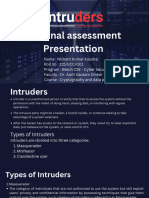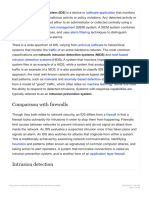0% found this document useful (0 votes)
12 views4 pagesChapter 3
An Intrusion Detection System (IDS) monitors network traffic for malicious activities and alerts administrators of potential threats. IDS can be classified into five types: Network, Host, Protocol-based, Application Protocol-based, and Hybrid systems, each serving different monitoring needs. Intrusion Prevention Systems (IPS) enhance IDS by actively blocking threats and are categorized into Network-based, Wireless, Network behavior analysis, and Host-based systems.
Uploaded by
subhayanchatterjee7Copyright
© © All Rights Reserved
We take content rights seriously. If you suspect this is your content, claim it here.
Available Formats
Download as PDF, TXT or read online on Scribd
0% found this document useful (0 votes)
12 views4 pagesChapter 3
An Intrusion Detection System (IDS) monitors network traffic for malicious activities and alerts administrators of potential threats. IDS can be classified into five types: Network, Host, Protocol-based, Application Protocol-based, and Hybrid systems, each serving different monitoring needs. Intrusion Prevention Systems (IPS) enhance IDS by actively blocking threats and are categorized into Network-based, Wireless, Network behavior analysis, and Host-based systems.
Uploaded by
subhayanchatterjee7Copyright
© © All Rights Reserved
We take content rights seriously. If you suspect this is your content, claim it here.
Available Formats
Download as PDF, TXT or read online on Scribd
/ 4



























































































